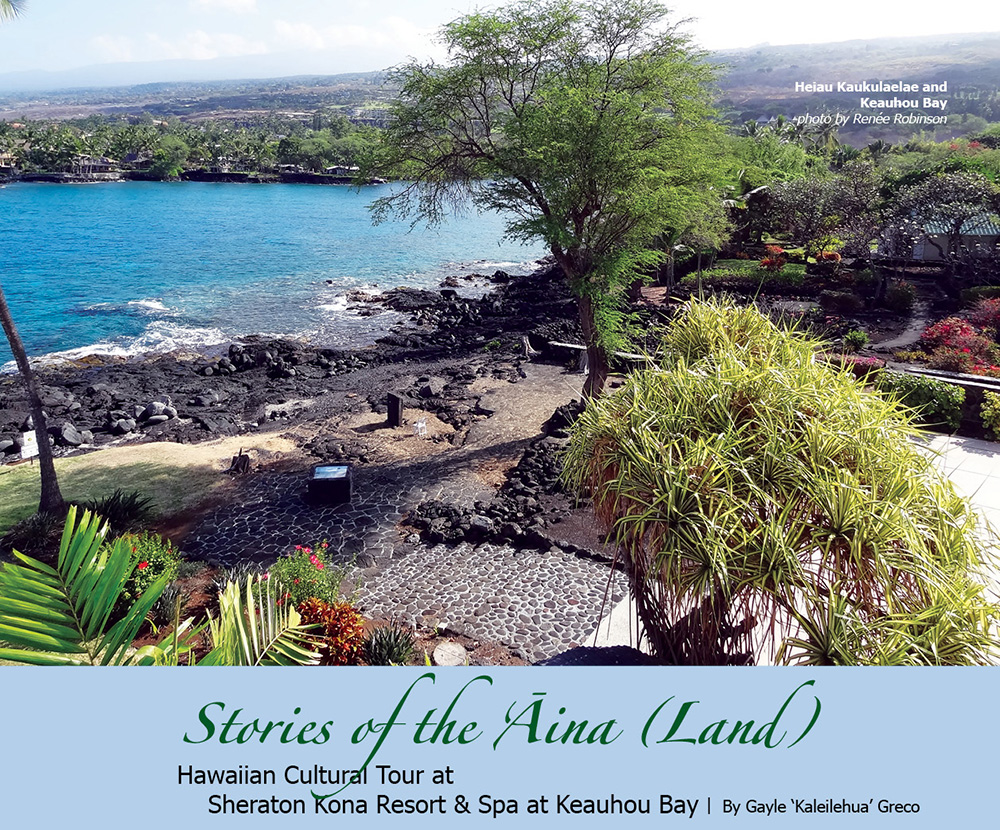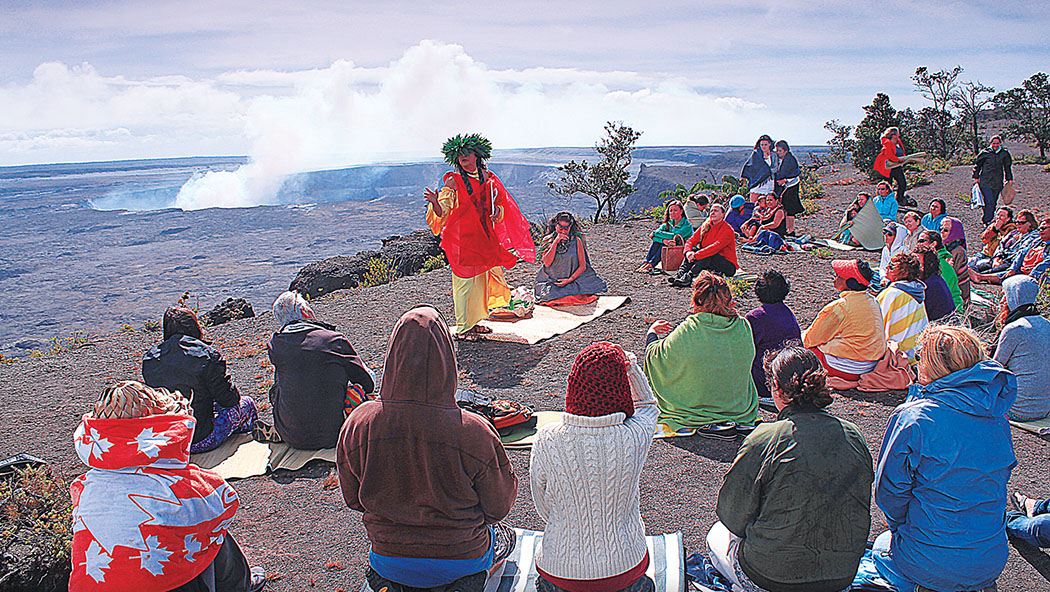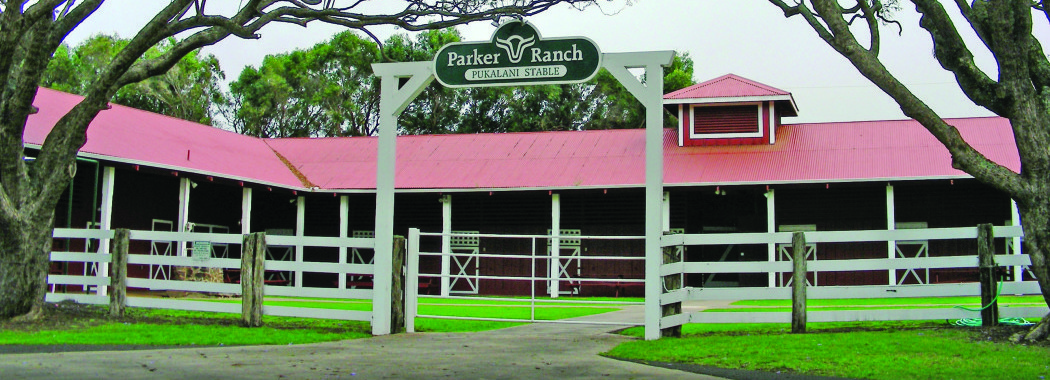
Hawaiian Cultural Tour at Sheraton Kona Resort & Spa at Keauhou Bay
By Gayle Kaleilehua Greco
To hear, ‘the answer is in the land,’ was the biggest blessing of my life,” says Lily Dudoit, Director of Culture at the Sheraton Kona Resort & Spa at Keauhou Bay.
Lily tells tales of royalty and deities; of lively games and fierce battles; of the Hawaiians’ language, arts, music, and dance. She feels it is her kuleana (responsibility) to document the kūpuna’s (elder’s) stories of the land.
Lily also describes with vivid delivery how a fishing village once thrived in Keauhou, a community six miles south of Kailua-Kona.
Salt was made from seawater, carving bowls from coconut shells, and strings of oily nuts from the kukui (candlenut tree) were burned for light in those days.
Home to several heiau (places of worship) and culture preserve areas, she describes the beauty and power of nature, which gave na po‘e kahiko (the people of old) sustenance and was their compass, pharmacy, and the foundation of their religion.
“The ‘āina (land) is the ancestor that is the storyteller. Our kuleana is to listen, feel, pule (pray), connect and allow the ‘āina to tell the story,” Lily recites as if the words were given to her from a source of long ago.
It is with this respect and knowledge that the cultural and historical tours at the Sheraton Kona came to life. Lily received a call one day in 2008 from a woman on O‘ahu who was planning to attend the Kūpuna Hula Festival at the hotel.
“The woman said she was supposed to bring a ho‘okupu (ceremonial gift) to the menehune heiau on property, but she didn’t know what would be appropriate,” Lily says, continuing, “I told her I didn’t know about that heiau, but I would find out.”
Lily placed a call to Aunty Lily Ha‘anio Kong, a respected cultural resource and kupuna of Keauhou.
Aunty Lily came to the hotel to meet with Lily and began to guide her through stories about the land. Aunty Lily shared the story of Kanikanika‘ula, a fishing heiau, where there is also a tree known as the “menehune tree’.
Lily says, “I found out the menehune heiau the woman had asked about was actually the fishing heiau. That was the beginning of everything.”
Lily’s passion was ignited and she expressed her desire to study and share Keauhou’s history. Aunty Lily replied, “We trust you. I know you’ll do what’s right for the place. You have our blessing.”
Another instruction was given to Lily: “The answer is in the land; everything you need to bring out the culture of this place is right around you. Listen, feel, look: it’s all right here.”
Lily knew without a doubt she needed to bring the cultural responsibility to the hotel management, and when she did, they agreed and embraced the kuleana to honor the land where the hotel resides.
For the next year and a half, Lily did her research, both in books and through the stories of the kūpuna. Aunty Lily Kong became Lily’s mentor, reassuring her when she was in doubt, suggesting new paths when she seemed to reach a dead end, and pointing out that some of the most important discoveries would be life lessons.
Spending many hours reviewing old maps, documents, and photographs at the Kona Historical Society and the Bishop Museum’s archives, Lily discovered records by Henry Kekahuna, a longtime assistant to the museum’s renowned archaeologist, Dr. Kenneth Emory.
“Mr. Kekahuna was known for his maps of numerous archaeological sites on Hawai‘i Island,” Lily recounts. “They include detailed notes and illustrations. In one of his notebooks, he describes Keauhou as a ‘supremely sacred’ village and ‘proudest of Royal lands.’”
At the Bishop Museum’s archives, Lily found John Reinecke’s accounts of Kaukulaelae from the 1930s. Reinecke was one of Hawai‘i’s leading sociolinguists in the 1930s and 1940s.
Additionally, Lily found five books in storage at the hotel, which were written by Cultural Surveys of Hawai‘i in 2003. When Lily opened the books, she found all the sketches and documentation of the land’s history. Here it was: the ‘āina was weaving a story to share through historical logs and generational stories.
In 2009, Lily created a cultural walk as a self-guided tour that highlighted several historical sites on Sheraton Kona’s grounds. Before the tour was offered to hotel guests, all of the hotel’s employees were escorted on the tour in small groups, as well as all new hires as part of their orientation.
“The thought is ‘hānai mua ia loko’— feed within before you give out,” Lily says.
She expands, “Give knowledge to those in your house before you give it to anyone else. It is important for our employees to honor the land, culture, and history of Keauhou and those who lived where we walk every day. We are now the caretakers of Keauhou, and our kuleana is to provide authentic experiences that help guests develop a strong connection with the Hawaiian culture, the people of Hawai‘i, and this special place.”
The cultural walk became available as a guided option in 2011, with a recent addition of a canoe ride, now known as the Historic Keauhou Bay by Land & Sea Experience. Seven months later, the Sheraton Kona introduced a second guided walk, Holoholo Keauhou, which goes to the Lekeleke Burial Grounds.
Keauhou’s historic land truly represents the foundation of a Hawaiian legacy. From remnants of long-ago dwellings to landscaping that celebrates the flora of Hawai‘i, there is much to see on the grounds of the Sheraton Kona.
You can experience over a dozen well-marked ancient sites, including a heiau.
As you walk the grounds, you can feel the essence of what the early lifestyle was like for the Hawaiian ancestors here. A reconstructed map shows a large platform, most likely a Hawaiian fishing shrine, with the Kū‘ula stone for offerings.
Indented stones found in the area were used for collection of sea salt called pa‘akai, a much sought after commodity of Keauhou in ancient times. Stacked stones found along the shoreline are remnants of a cattle pen, a canoe shed, and a platform where a home stood long ago. These remnants help develop a picture of what village life could have been like at Keauhou Bay.
A few of the historic sites at and near the Sheraton Kona are:
- Heiau Kaukulaelae: It is thought that the promontory may have been one of the highest elevation points in Keauhou. Today, only a few features associated with Heiau Kaukulaelae remain, including a cattle pen, canoe shed, and terrace.
- Kanikanika‘ula Heiau: This platform site was most likely a Hawaiian fishing shrine used as a place of worship for fisherman. Offerings were probably placed on the fishing shrine to help attract marine resources into Keauhou Bay.
- Kū‘ula Stone: A stone God used to attract fish: the stone could be carved or natural, enormous or tiny; it is named for the god of fishermen.
- Pa‘akai (Salt) Pans: Sea water would gather in the indentation of the rock. Once dried, the salt was gathered and used. Salt is used for healing and cleansing and in Hawaiian blessings.
- Kahua Hale: A modern house platform built on a probable prehistoric habitation terrace.
- Bell Stone: When hit in just the right spot with a sort of baton, the bell stone would send off a sound that could be heard throughout the village.
- He‘eia Bay: Was a favorite surfing spot by the Ali‘i (Royalty).
- Hōlua Slide: A National Historic Landmark, located mauka or upland of Ali‘i Drive above the resort. Contestants of chiefly rank would participate in sled races that would end near Keauhou Bay. The portion that remains is possibly over 1,000 feet long; originally the slide may have been up to 4,000 feet or longer. Kamehameha the Great had this slide built for his son Kauikeaouli, King Kamehameha III.
In June 2011, Lily was appointed as the Director of Culture which enabled her to focus on the cultural programs full time. It is a calling she takes very seriously. Each tour ends with Lily giving an ‘oli (chant) explaining that “we give back to nature because of all that it provides for us; we cannot take these gifts for granted.”
In the chant, a gift for the ‘āina, she expresses thanks on behalf of the group for the privilege of being there and for the knowledge she has been blessed to receive and pass on to others. She affirms the desire of everyone present to live aloha: to be kind, modest, gentle, humble, patient, and to be in harmony and have pleasant thoughts.
“I ask guests to take a moment to say mahalo (thank you) before swimming in the ocean, going on a hike in the mountains, and enjoying their other vacation activities,” Lily says. “On the tour, I’m not just sharing historical facts with them, I’m trying to help them understand and experience the Hawaiian way of thinking.” Lily continues, “Our hope is that we can make our guests be better visitors, to be more respectful wherever they go in the world, even in their own community.”
Lily hopes to add more cultural activities and programs, envisioning Sheraton Kona as an educational resource for the community as well as guests.
“Above all, in whatever I do, I want to be sure that the ancestors’ mo‘olelo (stories) are told,” she says.
Lily says her journey has been guided by this statement from Mary Kawena Pukui’s book, ‘Ōlelo No‘eau, “I ulu no ka lala i ke kumu,” meaning, the branches grow because of the trunk; without our ancestors we would not be here.
To Lily, connecting to the ‘āina and kūpuna and sharing their stories keeps the Hawaiian culture alive.
“Walk with me,” Lily says. “Lend me your ear. Give me a little time, and the cliffs, the ocean, the trees, and even seemingly random piles of rocks will come alive for you.”
The Sheraton Kona Resort & Spa at Keauhou Bay offers tours available to the general public as well as hotel guests. ❖
Contact Lily Dudoit: 808.930.4894
Contact writer Gayle Kaleilehua Greco



